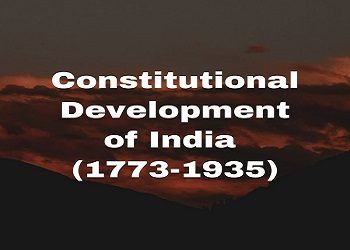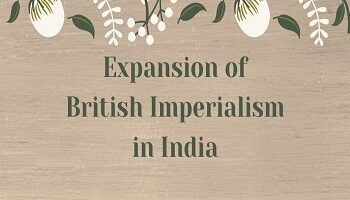Table of Contents
Constitutional Development of India:
The Regulating Act, 1773:
- The Regulating Act was passed by the British Parliament in 1773.
- By this legislation, the parliament sought to regulate the Company to a limited extent.
- Hereafter, the Directors of the Company were duty-bound to present before the British Government all correspondence relating to civil, military and revenue affairs in India.
- The Act laid down that the Government of Bengal would be headed by the Governor-General and a Council comprising four members.
- The Governments of the two other Presidencies were made subordinate to the government of Bengal.
- The British authorities at Bombay or Madras had no power to strike an alliance with or declare war against any other power.
- The Act also provided for the establishment of a Supreme Court in Calcutta to administer justice to the Europeans and their employees.
- In tune with this provision, the first Supreme Court was established in Calcutta in 1774.
- Sir Elija Impey became the first Chief Justice of the Supreme Court.
- Hereafter, the Governor of Bengal came to be known as the ‘Governor-General of Bengal‘.
- Warren Hastings was the first Governor-General of Bengal.
- The Governor-General was required to run the Governemnt of Bengal according to the decision taken in the council by a majority vote.
- The Governor-General had no power to overrule the decision of the Council, though he had a casting vote in case the house was divided equally on a given issue.
Pitt’s India Act, 1784:
To rectify the shortcomings of the Regulating Act, in 1784, William Pitt, the Prime Minister of Britain, introduced another act, known as Pitt’s India Act.
- Initiated system of double government.
- Creation of Board of Control in England consisting of six members inclusive of two cabinet Ministers & this was to control the court of directors. The Board was given comprehensive powers of supervision, direction and control over the Indian administration.
- A secret committee of three directors to replace the court of directors in Political & military affairs.
- Governor-General Council to include three members & one member was Commander-in-Chief.
- Governor-General had no power to override the council.
Charter Act of 1813:
- The sovereignty of the crown over the territories acquired by an East India Company established.
- The monopoly of East India Company abolished except for tea trade & trade with China.
- Christian missionaries allowed in India.
- The British Parliament directed East India Company to spend one lakh rupees per annum on the development of education in the British-occupied territory.
Charter Act of 1831:
- The monopoly of East India Company over tea & China trade abolished.
- Governor-General of Bengal became Governor-General of India. All the three Presidency came under the Governor-General of India & his council. Lord William Bentick was the 1st Governor-General of India.
- Act of 1833 brought about significant change in Governor-General Council. It made the beginning of Governor-General Legislative Council, 4th member added that was for legislative work and was known as law member. Macauley was the first law member. Law member was to be present in the council when it deals with legislative work.
- Provision of no disqualification for Indians for any office.
- Financial Centralisation– the entire proceeds of revenue to form a Single fund under Governor-General & his council.
Charter Act of 1853:
- Expanded Governor-General legislative council.
- It had the provision for throwing open the services to competition.
- Law member was made a full member of Governor-General Council.
Government of India Act of 1858:
- East India Company’s rule came to an end and the Indian administration came under the direct control of the Crown.
- The Governor-General of India was given an additional title, the Viceroy, as a representative of the British Crown. The first Viceroy of India was Lord Canning. By a special Act, both the Board of Directors and the Board of Control were abolished. In their place the office of the Secretary of State for India was created. He was assisted by an Indian Council of 15 members.
Indian Council Act of 1861:
- Provided for Legislative Council in Bombay, Madras and Calcutta and for the nomination of Indian Members called “non-official members“.
- Under the Act, Lord Canning introduced “Portfolio System” (allocation of departments for the first time).
Indian Council Act of 1892:
- The number of elected members in Central Legislative Council and the Provincial Legislative Council increased.
- The Council acquired the right to discuss on budget, but was not permitted to vote on it.
Indian Council Act 1909 (Morley-Minto Reforms):
- Separate communal electorates to the Muslims.
- For the first time, Indians were allowed to be appointed in the Viceroy’s Executive Council [Satyendra Prasad Sinha (SP Sinha) became the first Indian appointed to the Executive Council and was given Law portfolio].
Government of India Act 1919 (Montagu-Chelmsford Reforms):
- Dyarchy at the provincial level. Under dyarchy, the subjects of power were divided into reserved and transferred. Under reserved subjects like finance, internal order, jails, revenue were administered by Governor and his Executive Council. The transferred subjects like education, public health, sanitation, municipal administration, irrigation and industries were to be administered by Governor and his Council of Ministers.
- The act provided for the first time general (direct) elections. The elected governments at the provincial level would administer the transferred subjects.
- Bicameral Legislature (Council of States- the Upper House and Central Legislative Assembly- the Lower House) were introduced at the Central level.
- Devolution of Power was made for the first time dividing the powers into Central and Provincial.
- The office of the Indian High Commissioner was created for the first time in London to promote cultural, trade and commercial contacts between England and India.
Government of India Act 1935:
- There was a provision for a federal structure in India. It had to consist of British India and Indian States but it was subject to certain condition i.e. the approval of atleast 50% of Indian states. As the subsequent events proved that this condition could not be fulfilled so this federal structure did not come into existence.
- In central administration some sort of Dyarchy system was adopted and the British viceroy was given many privileges and safeguards.
- In provinces in place of Dyarchy the Provincial Autonomy was accepted. In other word, we can say in provinces the responsible government was to be formed.
- In this council bill there was a provision for a Federal Court and a Reserve Bank of India.









Comments (No)